Understanding Salinity Intrusion and Residence Times in a Small-Scale Bar-Built Estuary under Drought Scenarios: The Maipo River Estuary, Central Chile
Abstract
:1. Introduction
2. Methods
2.1. Numerical Model
2.2. Numerical Simulation Setup
2.3. Model Validation
Model Performance
2.4. Simulated Scenarios
3. Results
3.1. Salinity Intrusion
3.2. Particle Dynamics in the Estuary
4. Discussion
5. Conclusions
Author Contributions
Funding
Institutional Review Board Statement
Informed Consent Statement
Data Availability Statement
Acknowledgments
Conflicts of Interest
Abbreviations
| MPs | microplastics |
| RSR | RMSE–observation standard deviation ratio |
| ERS | Estuarine Residence Time |
References
- McLusky, D.S.; Elliott, M. The Estuarine Ecosystem: Ecology, Threats, and Management; Oxford University Press: Oxford, UK, 2004. [Google Scholar]
- Day, J.W., Jr.; Kemp, W.M.; Yáñez-Arancibia, A.; Crump, B.C. Estuarine Ecology; John Wiley & Sons: Hoboken, NJ, USA, 2012. [Google Scholar]
- Wainger, L.A.; Secor, D.H.; Gurbisz, C.; Kemp, W.M.; Glibert, P.M.; Houde, E.D.; Richkus, J.; Barber, M.C. Resilience indicators support valuation of estuarine ecosystem restoration under climate change. Ecosyst. Health Sustain. 2017, 3, e01268. [Google Scholar] [CrossRef]
- Barbier, E.B.; Hacker, S.D.; Kennedy, C.; Koch, E.W.; Stier, A.C.; Silliman, B.R. The value of estuarine and coastal ecosystem services. Ecol. Monogr. 2011, 81, 169–193. [Google Scholar] [CrossRef]
- Gillanders, B.M.; Elsdon, T.S.; Halliday, I.A.; Jenkins, G.P.; Robins, J.B.; Valesini, F.J. Potential effects of climate change on Australian estuaries and fish utilising estuaries: A review. Mar. Freshw. Res. 2011, 62, 1115–1131. [Google Scholar] [CrossRef]
- Robins, P.E.; Skov, M.W.; Lewis, M.J.; Giménez, L.; Davies, A.G.; Malham, S.K.; Neill, S.P.; McDonald, J.E.; Whitton, T.A.; Jackson, S.E.; et al. Impact of climate change on UK estuaries: A review of past trends and potential projections. Estuar. Coast. Shelf Sci. 2016, 169, 119–135. [Google Scholar] [CrossRef]
- Shaha, D.C.; Cho, Y.K.; Kim, T.W. Effects of river discharge and tide driven sea level variation on saltwater intrusion in sumjin river estuary: An application of finite-volume coastal ocean model. J. Coast. Res. 2013, 29, 460–470. [Google Scholar] [CrossRef]
- Ralston, D.K.; Geyer, W.R.; Lerczak, J.A. Structure, variability, and salt flux in a strongly forced salt wedge estuary. J. Geophys. Res. Oceans 2010, 115. [Google Scholar] [CrossRef]
- Ralston, D.K.; Geyer, W.R. Response to Channel Deepening of the Salinity Intrusion, Estuarine Circulation, and Stratification in an Urbanized Estuary. J. Geophys. Res. Oceans 2019, 124, 4784–4802. [Google Scholar] [CrossRef]
- Yang, Y.; Chen, X.; Li, Y.; Xiong, M.; Shen, Z. Modeling the Effects of Extreme Drought on Pollutant Transport Processes in the Yangtze River Estuary. J. Am. Water Resour. Assoc. 2015, 51, 624–636. [Google Scholar] [CrossRef]
- Cohen, J.H.; Internicola, A.M.; Mason, R.A.; Kukulka, T. Observations and Simulations of Microplastic Debris in a Tide, Wind, and Freshwater-Driven Estuarine Environment: The Delaware Bay. Environ. Sci. Technol. 2019, 53, 14204–14211. [Google Scholar] [CrossRef]
- Wan, Y.; Qiu, C.; Doering, P.; Ashton, M.; Sun, D.; Coley, T. Modeling residence time with a three-dimensional hydrodynamic model: Linkage with chlorophyll a in a subtropical estuary. Ecol. Model. 2013, 268, 93–102. [Google Scholar] [CrossRef]
- Cordero-Acosta, J.R.; Díaz, L.J.O.; Álvarez, A.E.H. Influence of Fluvial Discharges and Tides on the Salt Wedge Position of a Microtidal Estuary: Magdalena River. Water 2024, 16, 1139. [Google Scholar] [CrossRef]
- Milliman, J.D.; Syvitski, J.P. Geomorphic/tectonic control of sediment discharge to the ocean: The importance of small mountainous rivers. J. Geol. 1992, 100, 525–544. [Google Scholar] [CrossRef]
- McSweeney, S.; Kennedy, D.; Rutherfurd, I.; Stout, J. Intermittently Closed/Open Lakes and Lagoons: Their global distribution and boundary conditions. Geomorphology 2017, 292, 142–152. [Google Scholar] [CrossRef]
- Izett, J.G.; Fennel, K. Estimating the cross-shelf export of riverine materials: Part 2. Estimates of global freshwater and nutrient export. Glob. Biogeochem. Cycles 2018, 32, 176–186. [Google Scholar] [CrossRef]
- Parque humedal río Maipo. Avifauna. Available online: https://humedalriomaipo.cl/fauna-2/ (accessed on 1 June 2023).
- Ingenieros Integrales Ltda. INFORME AMBIENTAL Modificación PRC de San Antonio Sector Portuario Sur; Technical Report; Ilustre Municipalidad de San Antonio: San Antonio, Chile, 2012. [Google Scholar]
- Piñones, A.; Valle-Levinson, A.; Narváez, D.A.; Vargas, C.A.; Navarrete, S.A.; Yuras, G.; Castilla, J.C. Wind-induced diurnal variability in river plume motion. Estuar. Coast. Shelf Sci. 2005, 65, 513–525. [Google Scholar] [CrossRef]
- Salcedo-Castro, J.; Saldías, G.S.; Saavedra, F.; Donoso, D. Climatology of Maipo and Rapel river plumes off Central Chile from numerical simulations. Reg. Stud. Mar. Sci. 2020, 38, 101389. [Google Scholar] [CrossRef]
- Salcedo-Castro, J.; Olita, A.; Saavedra, F.; Saldías, G.S.; Cruz-Gómez, R.C.; Martínez, C.D.D.L.T. Modeling the interannual variability in Maipo and Rapel river plumes off central Chile. Ocean Sci. 2023, 19, 1687–1703. [Google Scholar] [CrossRef]
- Flores, R.P.; Williams, M.E.; Horner-Devine, A.R. River Plume Modulation by Infragravity Wave Forcing. Geophys. Res. Lett. 2022, 49. [Google Scholar] [CrossRef]
- Roco, A.; Flores, R.P.; Williams, M.E.; Saldías, G.S. Observations of river-wave interactions at a small-scale river mouth. Coast. Eng. 2024, 189, 104456. [Google Scholar] [CrossRef]
- Garreaud, R.D.; Boisier, J.P.; Rondanelli, R.; Montecinos, A.; Sepúlveda, H.H.; Veloso-Aguila, D. The central Chile mega drought (2010–2018): A climate dynamics perspective. Int. J. Climatol. 2020, 40, 421–439. [Google Scholar] [CrossRef]
- Dirección General de Aguas (DGA). Derechos de Aprovechamiento de Aguas Registrados en DGA. Available online: https://dga.mop.gob.cl/productosyservicios/derechos_historicos/Paginas/default.aspx (accessed on 10 January 2024).
- Akter, R.; Asik, T.Z.; Sakib, M.; Akter, M.; Sakib, M.N.; Azad, A.S.A.; Maruf, M.; Haque, A.; Rahman, M.M. The Dominant Climate Change Event for Salinity Intrusion in the GBM Delta. Climate 2019, 7, 69. [Google Scholar] [CrossRef]
- Pereira, H.; Sousa, M.C.; Vieira, L.R.; Morgado, F.; Dias, J.M. Modelling Salt Intrusion and Estuarine Plumes under Climate Change Scenarios in Two Transitional Ecosystems from the NW Atlantic Coast. J. Mar. Sci. Eng. 2022, 10, 262. [Google Scholar] [CrossRef]
- Rodrigues, M.; Fortunato, A.B.; Freire, P. Saltwater intrusion in the upper tagus estuary during droughts. Geosciences 2019, 9, 400. [Google Scholar] [CrossRef]
- Attrill, M.J.; Rundle, S.D. Ecotone or ecocline: Ecological boundaries in estuaries. Estuar. Coast. Shelf Sci. 2002, 55, 929–936. [Google Scholar] [CrossRef]
- Tuteja, N.; Peter Singh, L.; Gill, S.S.; Gill, R.; Tuteja, R. Salinity Stress: A Major Constraint in Crop Production. In Improving Crop Resistance to Abiotic Stress; John Wiley & Sons, Ltd.: Hoboken, NJ, USA, 2012; Chapter 4; pp. 71–96. [Google Scholar] [CrossRef]
- MacCready, P.; Geyer, W.R. Advances in estuarine physics. Annu. Rev. Mar. Sci. 2010, 2, 35–58. [Google Scholar] [CrossRef]
- Dijkstra, Y.M.; Schuttelaars, H.M. A Unifying Approach to Subtidal Salt Intrusion Modeling in Tidal Estuaries. J. Phys. Oceanogr. 2020, 51, 147–167. [Google Scholar] [CrossRef]
- Loose, B.; Niño, Y.; Escauriaza, C. Finite volume modeling of variable density shallow-water flow equations for a well-mixed estuary: Application to the Río Maipo estuary in central Chile. J. Hydraul. Res. 2005, 43, 339–350. [Google Scholar] [CrossRef]
- John, S.; Muraleedharan, K.R.; Revichandran, C.; Azeez, S.A.; Seena, G.; Cazenave, P.W. What controls the flushing efficiency and particle transport pathways in a tropical Estuary? Cochin Estuary, Southwest coast of India. Water 2020, 12, 908. [Google Scholar] [CrossRef]
- Hewageegana, V.H.; Olabarrieta, M.; Gonzalez-Ondina, J.M. Main Physical Processes Affecting the Residence Times of a Micro-Tidal Estuary. J. Mar. Sci. Eng. 2023, 11, 1333. [Google Scholar] [CrossRef]
- Frias, J.; Nash, R. Microplastics: Finding a consensus on the definition. Mar. Pollut. Bull. 2019, 138, 145–147. [Google Scholar] [CrossRef]
- Honorato-Zimmer, D.; Kiessling, T.; Gatta-Rosemary, M.; Kroeger Campodónico, C.; Núñez-Farías, P.; Rech, S.; Thiel, M. Mountain streams flushing litter to the sea – Andean rivers as conduits for plastic pollution. Environ. Pollut. 2021, 291, 118166. [Google Scholar] [CrossRef] [PubMed]
- Harris, P.T. The fate of microplastic in marine sedimentary environments: A review and synthesis. Mar. Pollut. Bull. 2020, 158, 111398. [Google Scholar] [CrossRef] [PubMed]
- Setälä, O.; Fleming-Lehtinen, V.; Lehtiniemi, M. Ingestion and transfer of microplastics in the planktonic food web. Environ. Pollut. 2014, 185, 77–83. [Google Scholar] [CrossRef] [PubMed]
- Nerland, I.L.; Halsband, C.; Allan, I.; Thomas, K.V. Microplastics in Marine Environments: Occurrence, Distribution and Effects; Technical Report; Norwegian Institute for Water Research: Oslo, Norway, 2014. [Google Scholar]
- Sharma, S.; Chatterjee, S. Microplastic pollution, a threat to marine ecosystem and human health: A short review. Environ. Sci. Pollut. Res. 2017, 24, 21530–21547. [Google Scholar] [CrossRef] [PubMed]
- Wendt, J.F. Computational Fluid Dynamics: An Introduction; Springer: Berlin/Heidelberg, Germany, 2008. [Google Scholar]
- Kundu, P.K.; Cohen, I.M.; Dowling, D.R. Fluid Mechanics; Academic Press: Cambridge, MA, USA, 2015. [Google Scholar]
- Zawawi, M.H.; Saleha, A.; Salwa, A.; Hassan, N.H.; Zahari, N.M.; Ramli, M.Z.; Muda, Z.C. A review: Fundamentals of computational fluid dynamics (CFD). AIP Conf. Proc. 2018, 2030, 020252. [Google Scholar] [CrossRef]
- Schulz, E.; Schuttelaars, H.M.; Gräwe, U.; Burchard, H. Impact of the depth-to-width ratio of periodically stratified tidal channels on the estuarine circulation. J. Phys. Oceanogr. 2015, 45, 2048–2069. [Google Scholar] [CrossRef]
- Alahmed, S.; Ross, L.; Smith, S.M. Coastal Hydrodynamics and Timescales in Meso-Macrotidal Estuaries in the Gulf of Maine: A Model Study. Estuaries Coasts 2022, 45, 1888–1908. [Google Scholar] [CrossRef]
- Chen, C.; Liu, H.; Beardsley, R.C. An Unstructured Grid, Finite-Volume, Three-Dimensional, Primitive Equations Ocean Model: Application to Coastal Ocean and Estuaries. J. Atmos. Ocean. Technol. 2003, 20, 159–186. [Google Scholar] [CrossRef]
- Chen, C.; Beardsley, R.; Cowles, G. An unstructured grid, finite-volume coastal ocean model (FVCOM) system. Oceanography 2006, 19, 78–89. [Google Scholar] [CrossRef]
- Huang, H.; Chen, C.; Cowles, G.W.; Winant, C.D.; Beardsley, R.C.; Hedstrom, K.S.; Haidvogel, D.B. FVCOM validation experiments: Comparisons with ROMS for three idealized barotropic test problems. J. Geophys. Res. Ocean. 2008, 113, 1–14. [Google Scholar] [CrossRef]
- Chen, C.; Qi, J.; Li, C.; Beardsley, R.C.; Lin, H.; Walker, R.; Gates, K. Complexity of the flooding/drying process in an estuarine tidal-creek salt-marsh system: An application of FVCOM. J. Geophys. Res. Ocean. 2008, 113. [Google Scholar] [CrossRef]
- Li, C.; Huang, W.; Milan, B. Atmospheric cold front-induced exchange flows through a microtidal multi-inlet bay: Analysis using multiple horizontal ADCPs and FVCOM simulations. J. Atmos. Ocean. Technol. 2019, 36, 443–472. [Google Scholar] [CrossRef]
- Xiao, Z.; Yang, Z.; Wang, T.; Sun, N.; Wigmosta, M.; Judi, D. Characterizing the Non-linear Interactions Between Tide, Storm Surge, and River Flow in the Delaware Bay Estuary, United States. Front. Mar. Sci. 2021, 8, 715557. [Google Scholar] [CrossRef]
- Liu, J.; Hetland, R.D.; Yang, Z.; Wang, T.; Sun, N. Response of Salt Intrusion in a Tidal Estuary to Regional Climatic Forcing (FVCOM Output for the baseline scenario). 2024. [Google Scholar] [CrossRef]
- Zhao, C.; Wang, N.; Ding, Y.; Song, D.; Li, J.; Li, M.; Zhou, L.; Yu, H.; Chen, Y.; Bao, X. Numerical Study on the Formation Mechanism of Plume Bulge in the Pearl River Estuary under the Influence of River Discharge. Water 2024, 16, 1296. [Google Scholar] [CrossRef]
- Rodi, W. Turbulence Models and Their Application in Hydraulics; Routledge: London, UK, 2000. [Google Scholar] [CrossRef]
- Moriasi, D.N.; Arnold, J.G.; Van Liew, M.W.; Bingner, R.L.; Harmel, R.D.; Veith, T.L. Model evaluation guidelines for systematic quantification of accuracy in watershed simulations. Trans. ASABE 2007, 50, 885–900. [Google Scholar] [CrossRef]
- Hendrickx, G.G.; Kranenburg, W.M.; Antolínez, J.A.; Huismans, Y.; Aarninkhof, S.G.; Herman, P.M. Sensitivity of salt intrusion to estuary-scale changes: A systematic modelling study towards nature-based mitigation measures. Estuar. Coast. Shelf Sci. 2023, 295, 108564. [Google Scholar] [CrossRef]
- Guha, A.; Lawrence, G.A. Estuary classification revisited. J. Phys. Oceanogr. 2013, 43, 1566–1571. [Google Scholar] [CrossRef]
- Ralston, D.K.; Cowles, G.W.; Geyer, W.R.; Holleman, R.C. Turbulent and numerical mixing in a salt wedge estuary: Dependence on grid resolution, bottom roughness, and turbulence closure. J. Geophys. Res. Ocean. 2017, 122, 692–712. [Google Scholar] [CrossRef]
- Dirección General de Aguas (DGA). Información Oficial Hidrometeorológica y de Calidad de Aguas en Línea. Available online: https://snia.mop.gob.cl/BNAConsultas/reportes (accessed on 15 August 2023).
- Biblioteca Nacional del Congreso de Chile. Criterios para la Determinación del Caudal Ecológico Mínimo para el Otorgamiento de Derechos de Aprovechamiento de Aguas. 2015. Available online: https://www.bcn.cl/leychile/navegar?idNorma=1053200 (accessed on 15 September 2023).
- Pawlowicz, R.; Beardsley, B.; Lentz, S. Classical tidal harmonic analysis including error estimates in MATLAB using T-TIDE. Comput. Geosci. 2002, 28, 929–937. [Google Scholar] [CrossRef]
- Monismith, S.G.; Burau, J.R.; Stacey, M.T. Structure and Flow-Induced Variability of the Subtidal Salinity Field in Northern San Francisco Bay. J. Phys. Oceanogr. 2002, 32, 3003–3019. [Google Scholar] [CrossRef]
- Liu, W.C.; Ke, M.H.; Liu, H.M. Response of salt transport and residence time to geomorphologic changes in an estuarine system. Water 2020, 12, 1091. [Google Scholar] [CrossRef]
- Miller, R.L.; McPherson, B.F. Estimating estuarine flushing and residence times in Charlotte Harbor, Florida. via salt balance and a box model. Limnol. Oceanogr. 1991, 36, 602–612. [Google Scholar] [CrossRef]
- de Pablo, H.; Sobrinho, J.; Garaboa-Paz, D.; Fonteles, C.; Neves, R.; Gaspar, M.B. The Influence of the River Discharge on Residence Time, Exposure Time and Integrated Water Fractions for the Tagus Estuary (Portugal). Front. Mar. Sci. 2022, 8, 734814. [Google Scholar] [CrossRef]
- Huang, W.; Liu, X.; Chen, X.; Flannery, M.S. Critical Flow for Water Management in a Shallow Tidal River Based on Estuarine Residence Time. Water Resour. Manag. 2011, 25, 2367–2385. [Google Scholar] [CrossRef]
- Kranenburg, W.M.; Kaaij, T.V.D.; Tiessen, M.; Friocourt, Y.; Blaas, M. Salt Intrusion in the Rhine Meuse Delta: Estuarine Circulation, Tidal Dispersion or Surge Effect? In Proceedings of the 39th IAHR World Congress, Granada, Spain, 19–24 June 2022. [Google Scholar] [CrossRef]
- Longuet-Higgins, M.S. Longshore currents generated by obliquely incident sea waves: 1. J. Geophys. Res. 1970, 75, 6778–6789. [Google Scholar] [CrossRef]
- Pezerat, M.; Bertin, X.; Martins, K.; Lavaud, L. Cross-shore distribution of the wave-induced circulation over a dissipative beach under storm wave conditions. J. Geophys. Res. Ocean. 2022, 127, e2021JC018108. [Google Scholar] [CrossRef]
- Pawlowicz, R.; Hannah, C.; Rosenberger, A. Lagrangian observations of estuarine residence times, dispersion, and trapping in the Salish Sea. Estuar. Coast. Shelf Sci. 2019, 225. [Google Scholar] [CrossRef]
- Sandoval, J.; Mignot, E.; Mao, L.; Pastén, P.; Bolster, D.; Escauriaza, C. Field and numerical investigation of transport mechanisms in a surface storage zone. J. Geophys. Res. Earth Surf. 2019, 124, 938–959. [Google Scholar] [CrossRef]
- Barros, M.; Escauriaza, C. Lagrangian and Eulerian perspectives of turbulent transport mechanisms in a lateral cavity. J. Fluid Mech. 2024, 984, A1. [Google Scholar] [CrossRef]
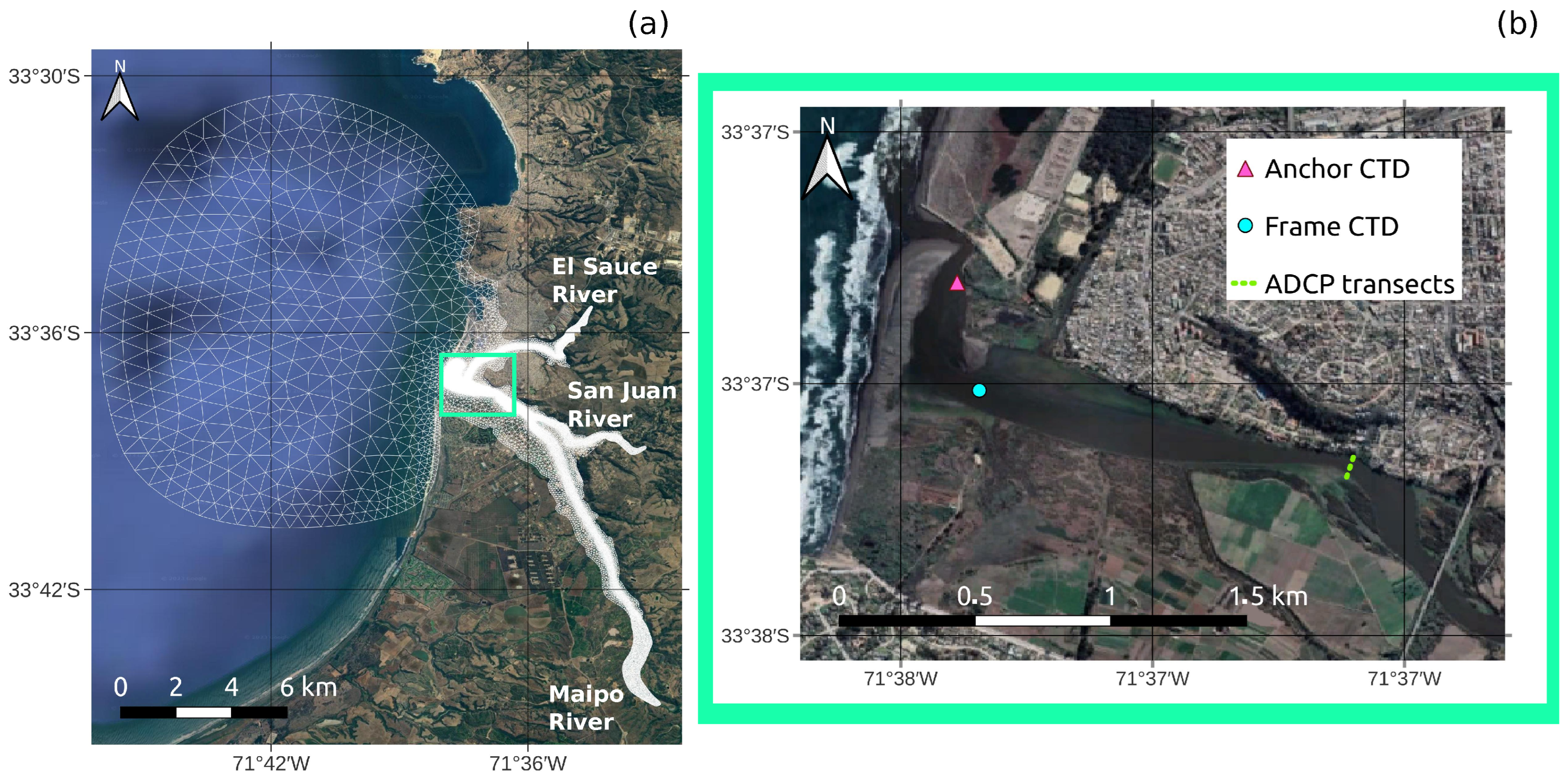
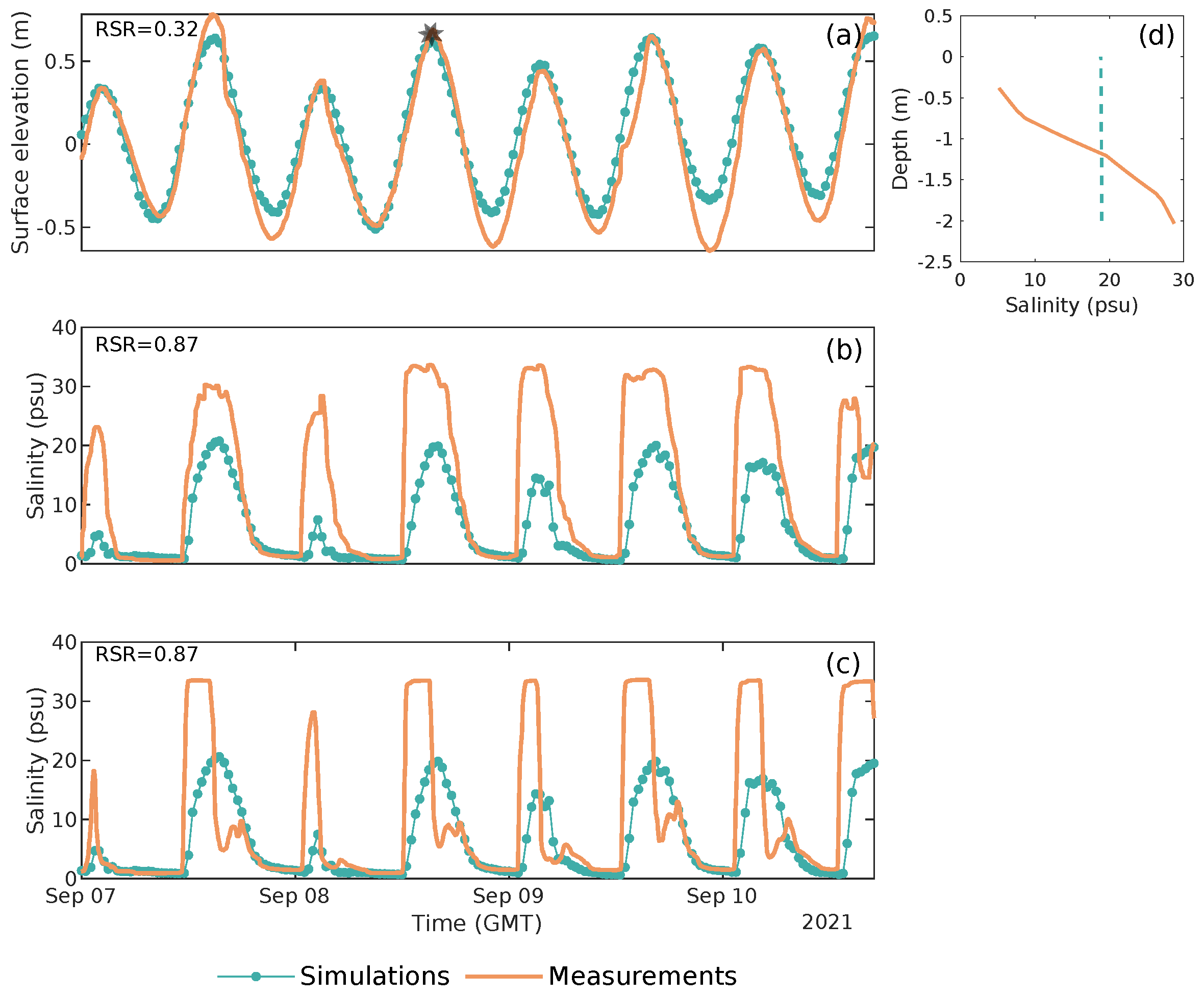

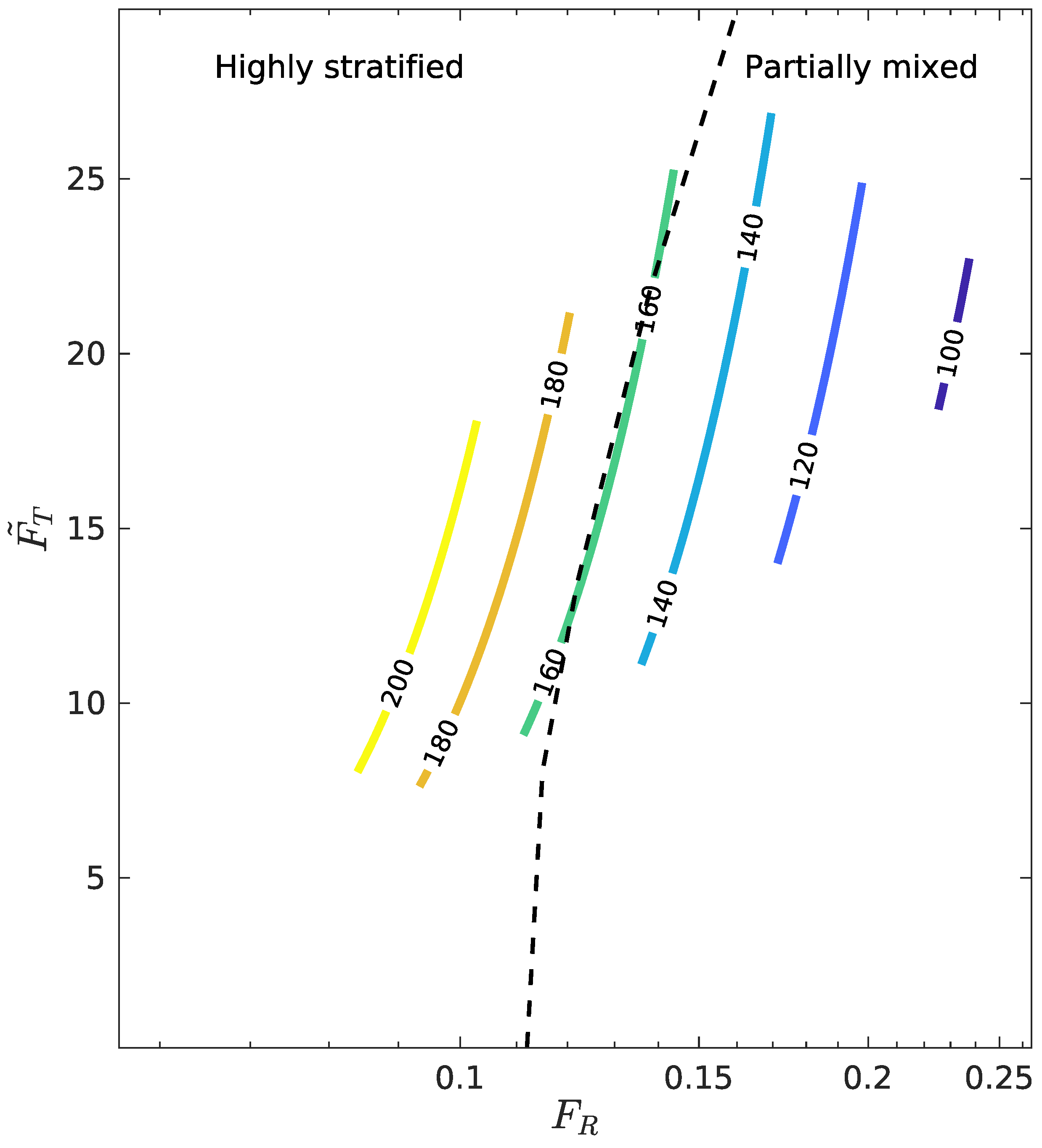
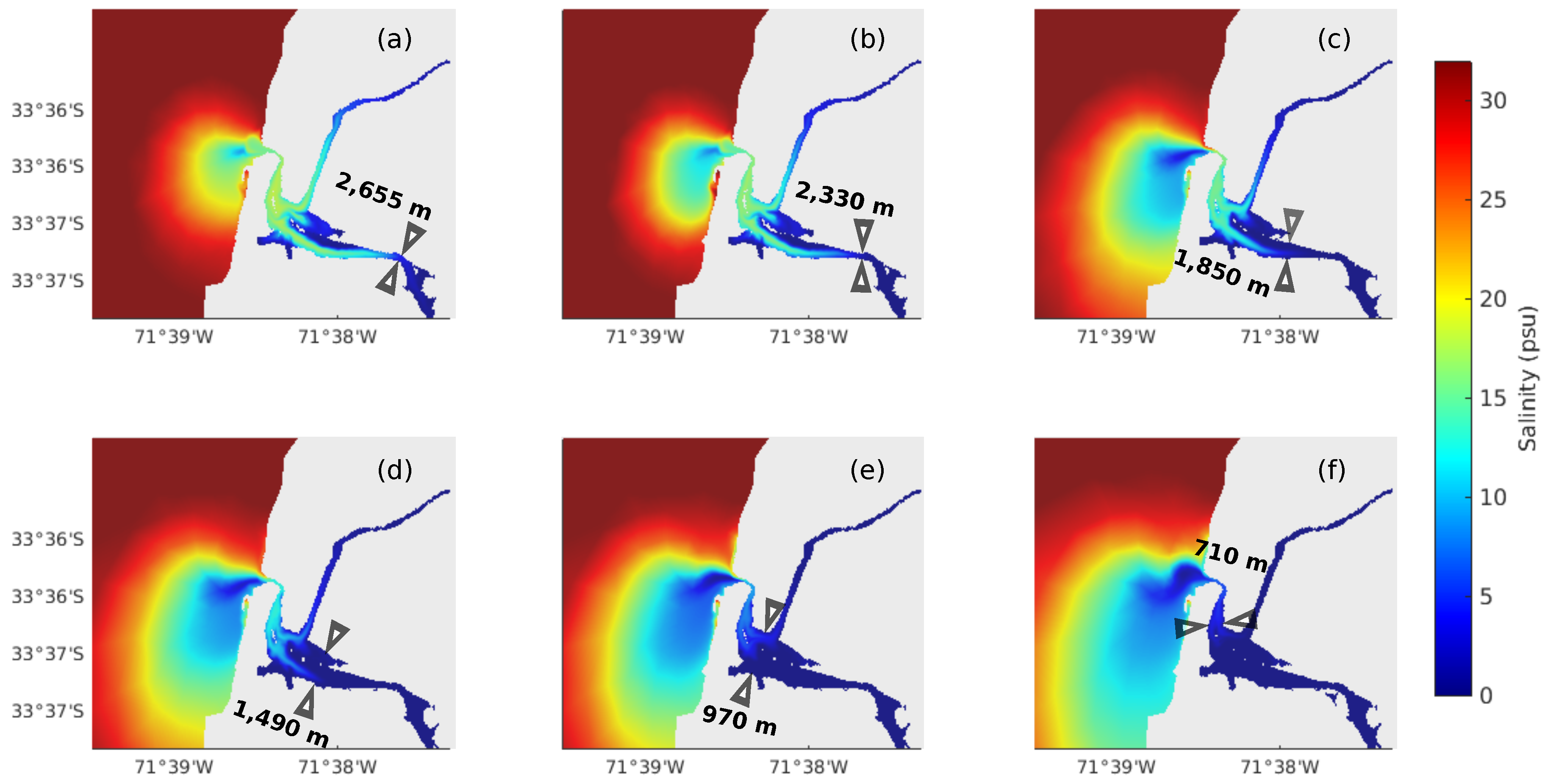
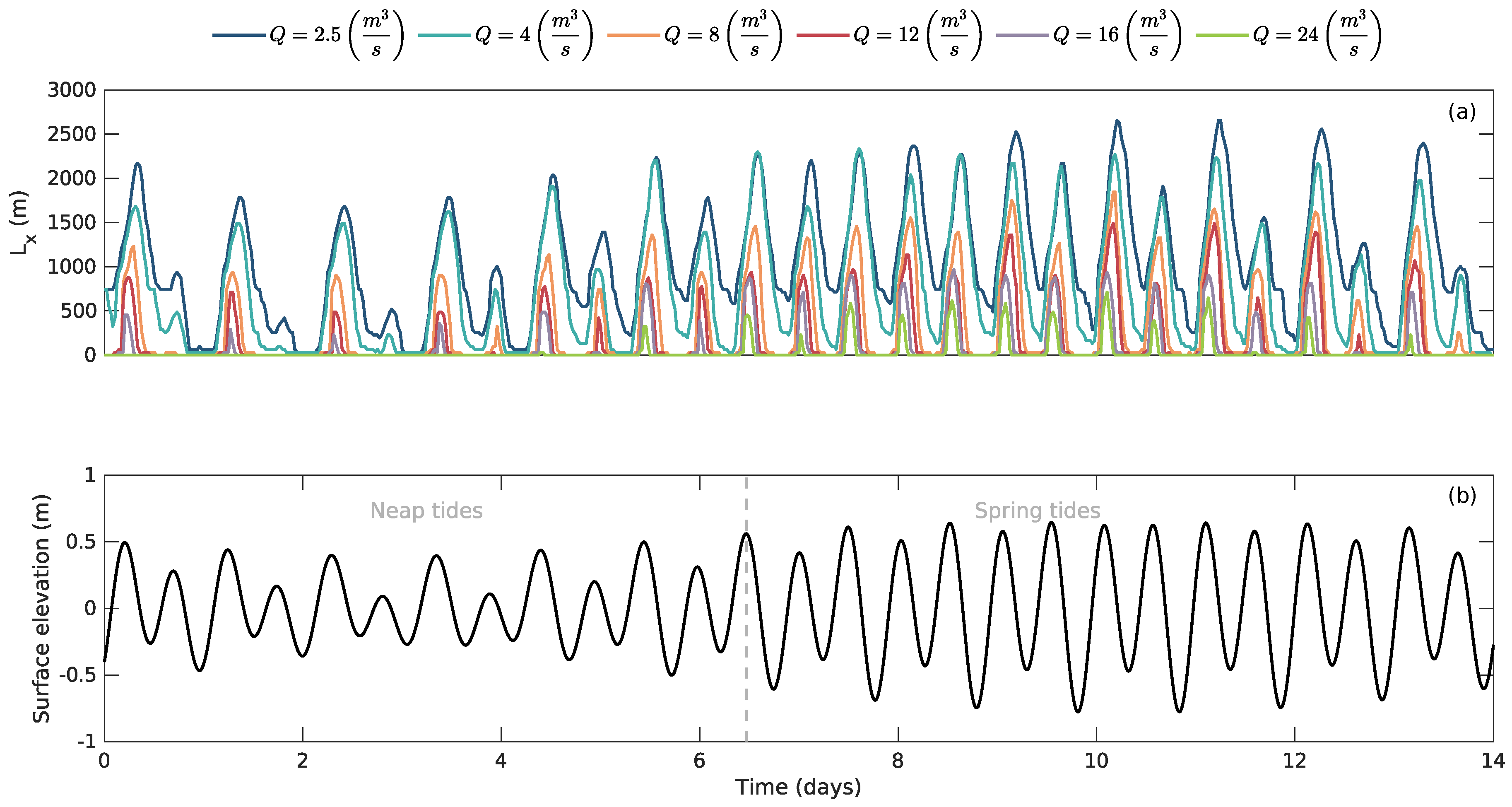
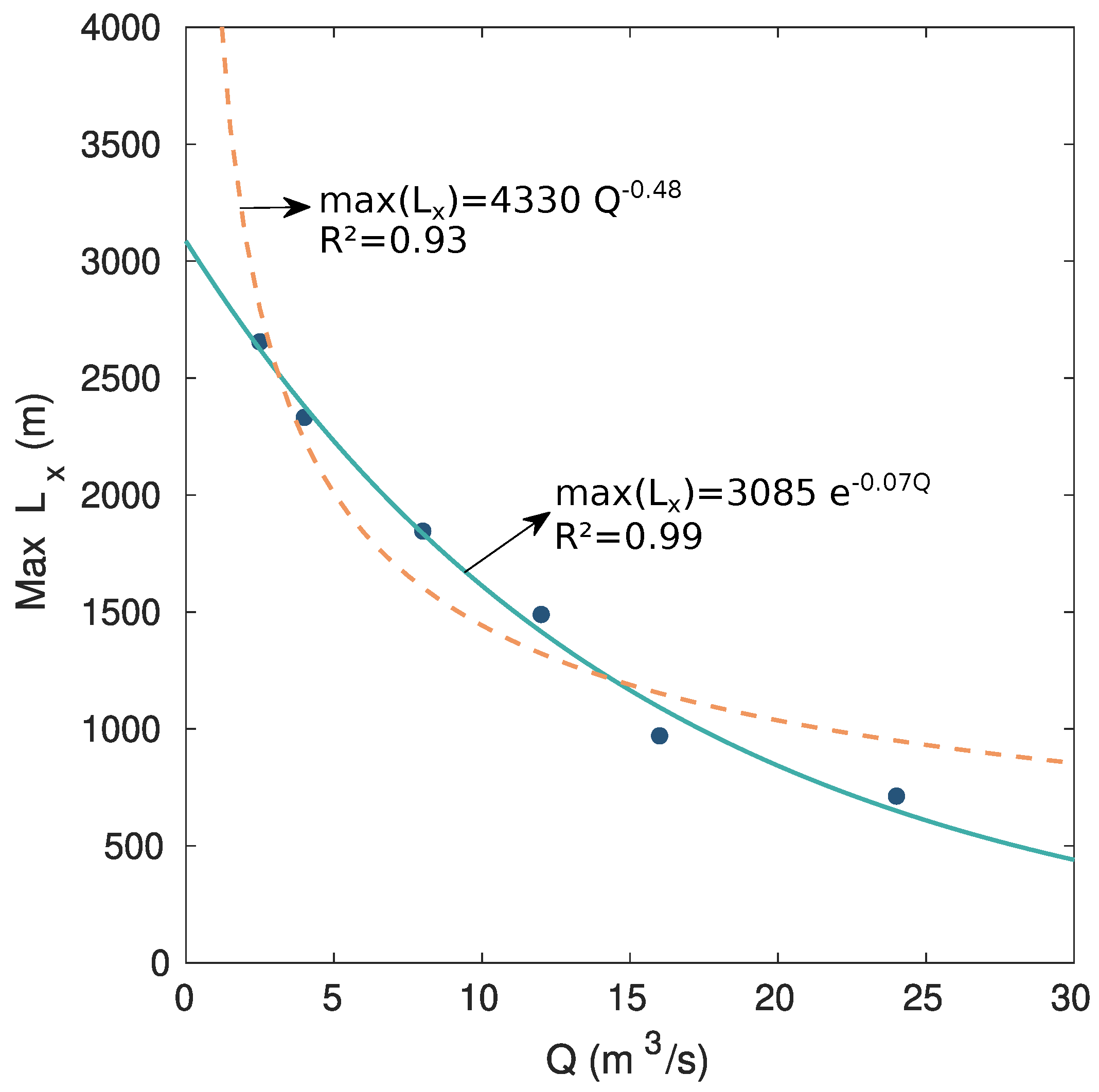

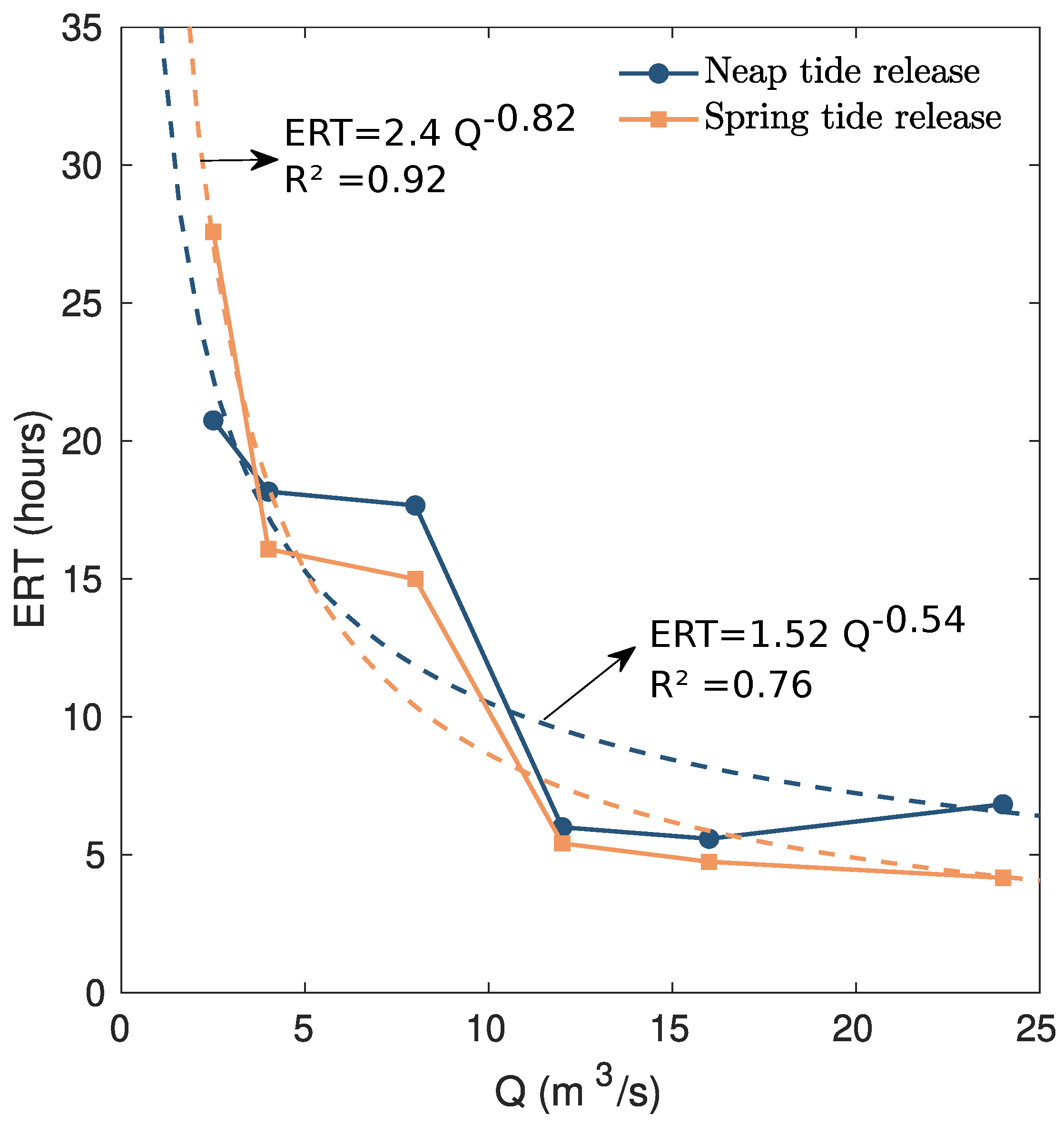

| Case | Q m3s−1 | |
|---|---|---|
| Case 1 | 2.5 | 0.03 |
| Case 2 | 4 | 0.05 |
| Case 3 | 8 | 0.10 |
| Case 4 | 12 | 0.14 |
| Case 5 | 16 | 0.19 |
| Case 6 | 24 | 0.29 |
Disclaimer/Publisher’s Note: The statements, opinions and data contained in all publications are solely those of the individual author(s) and contributor(s) and not of MDPI and/or the editor(s). MDPI and/or the editor(s) disclaim responsibility for any injury to people or property resulting from any ideas, methods, instructions or products referred to in the content. |
© 2024 by the authors. Licensee MDPI, Basel, Switzerland. This article is an open access article distributed under the terms and conditions of the Creative Commons Attribution (CC BY) license (https://creativecommons.org/licenses/by/4.0/).
Share and Cite
Soto-Rivas, K.; Flores, R.P.; Williams, M.; Escauriaza, C. Understanding Salinity Intrusion and Residence Times in a Small-Scale Bar-Built Estuary under Drought Scenarios: The Maipo River Estuary, Central Chile. J. Mar. Sci. Eng. 2024, 12, 1162. https://doi.org/10.3390/jmse12071162
Soto-Rivas K, Flores RP, Williams M, Escauriaza C. Understanding Salinity Intrusion and Residence Times in a Small-Scale Bar-Built Estuary under Drought Scenarios: The Maipo River Estuary, Central Chile. Journal of Marine Science and Engineering. 2024; 12(7):1162. https://doi.org/10.3390/jmse12071162
Chicago/Turabian StyleSoto-Rivas, Karina, Raúl P. Flores, Megan Williams, and Cristián Escauriaza. 2024. "Understanding Salinity Intrusion and Residence Times in a Small-Scale Bar-Built Estuary under Drought Scenarios: The Maipo River Estuary, Central Chile" Journal of Marine Science and Engineering 12, no. 7: 1162. https://doi.org/10.3390/jmse12071162
APA StyleSoto-Rivas, K., Flores, R. P., Williams, M., & Escauriaza, C. (2024). Understanding Salinity Intrusion and Residence Times in a Small-Scale Bar-Built Estuary under Drought Scenarios: The Maipo River Estuary, Central Chile. Journal of Marine Science and Engineering, 12(7), 1162. https://doi.org/10.3390/jmse12071162







